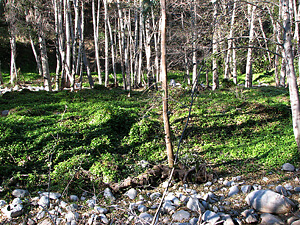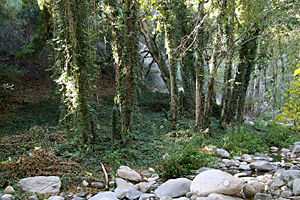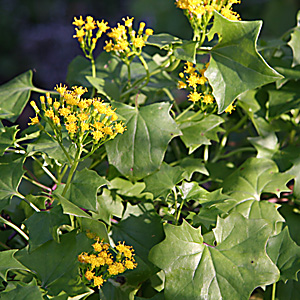Today's Arroyo Seco
by Gabi McLean
(reprinted with permission from the The Paintbrush, January-February 2008, San Gabriel Mountains Chapter of the California Native Plant Society)
|
The first time I hiked in the Arroyo was in 1989, on one of the many “Naturecize” hikes led by the late Pat Brame, an Eaton Canyon docent and naturalist. We met at the end of Altadena Drive and ventured into the cool canyon with year-round water and many stream crossings, following the water upstream towards Gould Mesa. I didn’t know the plants back then, but with Pat’s help and others later on, we learned the basics. I loved the many alders along the stream, the coast live oaks a little higher on the banks, the laurel sumac, sugar bush, yucca and elderberry in the occasional wider sections of the canyon. California sagebrush, coffeeberry, chaparral currant, the native California blackberry, a variety of ferns, and other plants gave this canyon its special charm. 
The walks in the canyon reminded me a little of the Black Forest as the steep canyon walls and the tall trees shaded much of the area. While the individual plants were very different from the forests in the old world, the canyon provided the same feel that I enjoyed in the woods back home – tall trees, shade, every so often a sunny opening, and the gurgle of the water rushing over the rocks. Rock-hopping was fun, and so was watching the birds, the lizards, and the occasional deer. As I learned more about our native plants, I came to recognize that this magical canyon harbored quite a few plants not from this area. The many cabin sites along the stream, whether abandoned or not, whether in use or totally destroyed, spoke of their history by virtue of the exotic plants around the site. English ivy and periwinkle were familiar to me, and now I recognized them as being out of place here. But it wasn’t until 2003 that I noticed things were changing. The English ivy – instead of climbing over cabin walls – was climbing up into the crown of the alders and the oaks, not only weighing heavy on those trees, but also taking away sunlight from above and nutrients from below. We also started seeing another ivy, one with bright green leaves and bright yellow flowers in winter. The cape ivy looks lush and happy, growing next to the English ivy, and spreading much faster than it’s European cousin (English ivy is in the Ginseng family, Cape ivy is from Africa and in the sunflower family). 
At a recent scouting trip, we recorded the spread of the cape ivy (Delairea odorata) from before the Angeles National Forest land, all along the stream in large patches, reaching upstream, until Teddy’s outpost and beyond. How far beyond, we still need to explore. In a study by Ellen Mackey in 2003, Cape ivy was recorded as far north as beyond the dam. |
The canyon beyond Gould Mesa changes character as the canyon walls retreat and give way to open space for cottonwoods, coastal sage scrub, and chaparral. The canyon walls are still steep, not affording access to Angeles Crest Highway to the west, or the ranges to the east. So it was quite disturbing to our small scouting party (Mickey Long, Cliff McLean, and myself) that the ivy continued to appear in large patches even in the more open, exposed environment. There was no way telling what was underneath the ivy, and whether what it covered was dead or alive. While in earlier trips, we could still recognize the species of shrub the ivy was growing over, this time there was nothing but ivy in the infested areas. Gone were the woodland species of ferns that would grace the area and be prevalent at this time of the year. Little hope is there for the Humboldt lily to be able to make a comeback – it was in this canyon that Roberta Ramsell introduced me with excitement to a Humboldt lily, the first lily that I had seen with whorled leaves. 
Not only English ivy and Cape ivy have taken a hold in the canyon, another invasive plant, too, has taken hold and overrun other, more delicate native species: Eupatory. This white-flowering member of the sunflower family loves to grow right at the water’s edge. It now grows just about all along the length of the creek in the area we surveyed. We have found Eupatory in many other canyons in the San Gabriels, but here it was almost to exclusion in its favorite habitat, directly at the water’s edge. I am worried about the frogs and toads who need a soft bank to burrow themselves into – the Eupatory changes the soft banks to a hardened maze of roots, unsuitable for our native amphibians. I am worried about the fish in the stream - the cape ivy contains pyrrolizidine alkaloids and xanthones that are toxic to humans, mammals and in particular aquatic organisms (Global Invasive Species Database, www.invasivespecies.net/database). Besides development, the invasion of aggressive exotic species is the greatest threat to our wildlands. Not only are we losing our native species, we are losing whole ecosystems if we are not observant and address this important issue. The CNPS state organization is currently working on a weed management policy and a herbicide application policy. Our chapter board is committed to working here close at home at this issue and we encourage you to hear and read more about this threat. We will have programs and projects in the coming year and invite you to join us in our attention to this real threat to the plants we love and that provide the basis for the native fauna and the web of life. |
Keywords: Gabi McLean, Cliff McLean, Gabriele McLean, Clifford McLean, Nature at Hand, Gabi Horn, Gabriele Horn, Plants of the San Gabriel Mountains: Foothills and Canyon, Interpretive Guide on CD, Plants of the San Gabriel Foothills and Canyons, California native plants, Pasadena, Los Angeles, Los Angeles County, San Gabriel Valley, Southern California, Covina, natural, nature photography, photograph, environmental education, naturalist, docent, hike, hiking, CD-ROM, California native garden, gardening, flowers, wildflowers, San Gabriel Mountains, Angeles National Forest, California Native Plant Society, CNPS, Eaton Canyon Nature Center Associates, ECNCA, Arroyo Seco, invasive weeds, invasive plants